Riding an adult tricycle is different from riding a regular bicycle, but not harder. The biggest obstacle to learning how to ride a tricycle is unlearning everything you know about riding a regular bicycle, sitting still, trusting the tricycle to take you forward, and working with your hands rather than your body.
This is an account of how I first learnt how to ride an adult tricycle. I will discuss my fears stepping onto the trike for the first time, how I managed to overcome them, and some tips I have learned along the way to becoming an experienced adult tricycle rider.
Riding an Adult Tricycle for the First Time
So, the year was 2021, and I led my Viribus TG1 Electric Tricycle to a park just outside my city. I had had a long career dealing in electric bicycles, but new opportunities were opening up in the electric tricycle market. I wanted to be at the forefront.
However, I do not sell anything to anybody unless I genuinely believe it is a good product: that’s just my policy. So, this was a potential pivot in my career, and it all depended on whether or not I could figure out how to ride this thing.
I set up my tricycle on the bike path, and I stepped on. This should be easy, right?
Wrong. It wasn’t…at least not at the beginning!
Rule No.1: Do Not Worry About Body Balance
The first challenge when riding an adult tricycle is dealing with the uncertainty and slight awkwardness of sitting still without needing to balance yourself. You cannot just sit on a regular two-wheeled bicycle with both feet on the pedals without falling off: on an adult tricycle, you can.
An adult tricycle balances itself. That is what threw me off at first. So, to ride an adult tricycle, understand that your body balance will have a smaller role to play.
Spend some time just sitting on the tricycle, and getting used to not having to put in any effort to balance yourself. This is a mental shift that you will have to make: you are not in control anymore.

How to Get Your Adult Tricycle to Move Forward
When it finally entered my mind that I would have to sit still and allow the natural balance of the three-wheeled bike to take over, the next question was: how do I move forward?
First, let's set the scene: I am on a straight path in the park, to my right, there is a patch of trees. I am trying to get the bike to move forward. What do I do?
I turned the bike on and pressed the throttle. The trike took me straight off the path, directly towards the nearby trees.
Luckily, I gripped the handbrakes in time. Then I stepped off and dragged the bike back onto the path.
What had just happened?
Then I stepped on again, relaxed, and pushed the gear forward.
Again, straight into the trees.
Rule No.2: Adult Tricycles Naturally Pull in One Direction
One of the feelings you will get once a three-wheel bike begins to move is that you have no control over where it is going. It seemed to me that the trike had a mind of its own, and it was determined to move in a straight line directly into the cluster of trees to my right.
Because a tricycle has three wheels, it naturally pulls in one direction. In other words, it tends to veer to one side. In my case, the trike veered to the right. That is why I felt like it was moving in a straight line into the trees
How to Keep Your Adult Tricycle on the Path
Your primary focus is to prevent the bike from straying off the path, which means you have to focus on operating the handlebars. To keep an adult tricycle on the path, you constantly have to direct it to the opposite side to which it naturally veers.
Rule No.3: Focus on the Handlebars
If the trike pulls to the right( like mine did), grab the handlebars and redirect it towards the left. Keep turning the handlebars to the left to ensure it does not leave the path.
If the path leads to the right ( the same direction to which your tricycle naturally veers), just sit back and let the trike go forward. When the path goes left (the opposite direction to which your trike naturally veers), grab the handlebars and gently steer it to the left.
Think of this like walking a dog with no fear of danger, and a really bad sense of direction: it keeps wanting to walk off the path into the highway on your right.
What do you do? You keep a tight hold on the leash and pull gently to the left to keep it on the sidewalk. As long as the path leads right, you are good. The moment it turns left, you gently pull the leash.

When learning how to ride an adult tricycle, your job is more about controlling the direction of the tricycle and less about getting it to move.
Riding an Adult Tricycle is Easier than You Think
When I finally figured out how and when to operate the handlebars, 90% of my work was done. I could just sit back and let the tricycle do its thing. All I had to do was gently restrict its automatic one-directional movements, keeping it on the path.
Rule No. 4: Practice Makes Perfect
This sounds a lot harder than it is. Remember, the tricycle is moving. Just like riding a regular tricycle, it comes to you naturally once you figure out what to do, and with even minimal practice, you should be able to ride an adult tricycle.
In less than two hours, I had fully learnt how to ride an adult tricycle, and I was riding in circles around the park. I could even move around obstacles in the relatively narrow path (elderly people and their stuff), and plow full speed ahead.
For context, it took me about three days, two falls, a bruised knee, and a ripped pair of jeans to learn how to ride a bicycle. Learning how to ride a tricycle took about two hours, and I emerged fully safe.
Rule No.5: Slow Down Around Corners/Bends in the Road
Given that the average speed for most electric tricycles for adults is about 15mph, and it is almost basic common sense, it seems almost unnecessary to caution people learning how to ride an adult tricycle to slow down around bends.
But I know how excited people can get when they learn something new. Plus, an adult tricycle, once you figure it out, is so easy to ride that one may be tempted to overlook the basics.

But here’s the thing: riding an adult tricycle can be dangerous if you speed around a bend.
- First, it is a lot easier for it to lose balance, and it is more likely to lose balance while making a turn at high speeds.
- Second, adult tricycles are heavy, and you have no control over them. If your trike were to turn over, there is no chance of you being able to protect yourself by twisting your body around, stretching out a leg, or doing anything to mitigate body damage.
So, for the sake of your safety, slow down before you make a turn.
Rule No.6:Enjoy the Ride
The good thing about riding an adult tricycle (electric tricycles in particular) is that they are much more fun and easier to ride than traditional tricycles. This is a major reason why adult tricycles are still worth it in 2025.
Recommended Adult Tricycles
- TG1 Plus Electric Tricycle
- TG1 Pro Electric Tricycle
- TG1 Folding Electric Tricycle
- SC5 Fat Tire Electric Tricycle
| Features | TG1 Plus Electric Tricycle | TG1 Pro Electric Tricycle | TG1 Folding Electric Tricycle | SC5 Fat Tire Electric Tricycle |
| Motor | 350 (Peak 500W) | 350W (Peak 500W) | 350W(peak 500W) | 500W(peak 750W) |
| Top Speed | 15.5mph | 15.5mph | 15.5mph | 20mph |
| Battery | 36V 13Ah, 468Wh SGS | 48V 13Ah UL certified | 36V 13Ah Ternary Lithium Battery | 48V 15Ah, 720 Wh Lithium-ion |
| Pedal Assist Range | 37miles | 53miles | 47 miles | 65 miles |
| Throttle Range | 31miles | 38.5 miles | 31 miles | 38 miles |
| Tire size | 24'' / 26'' | 24'' / 26'' x1.95 | 24''x1.95 | 20x3'' |
| Frame | Low step-thru/Carbon steel | Low step-thru/Carbon steel | Low step-thru/Carbon steel | Low step-thru/Aluminum frame |
| Total Weight Capacity | 330lb | 330 lb | 395 lb | 395 lb |
| Brakes | Double mechanical Disc brakes | Double Mechanical Disc brakes | Double Mechanical Disc brakes | Mechanical disc brakes |
| Basket(s) | Rear Basket (110lb) | Rear Basket (110lb) | Rear basket(110lb) | Rear basket (100 lb) |
| Throttle +Pedal Assist | Both | Both | Both | Both |
| Foldable | No | No | Yes | No |
| Fenders | Front and back | Front and back | Front and back | Front and back |

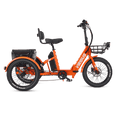

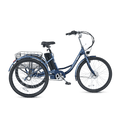
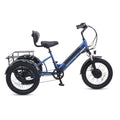
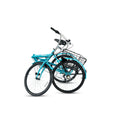
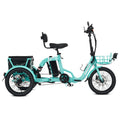

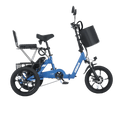

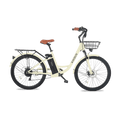
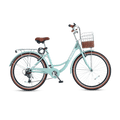
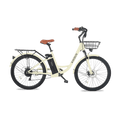
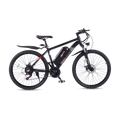
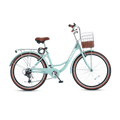
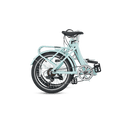
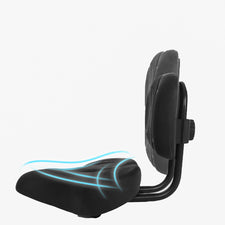





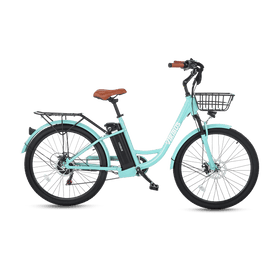
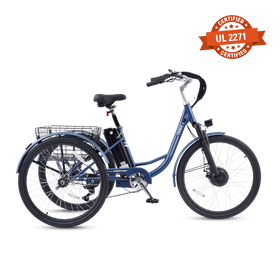
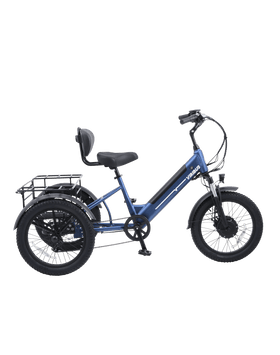



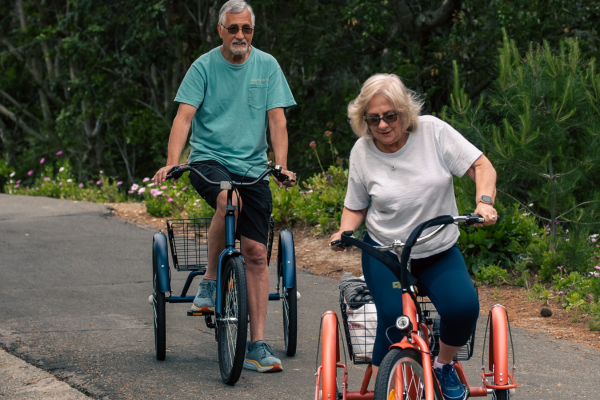

Leave a comment
All comments are moderated before being published.
This site is protected by hCaptcha and the hCaptcha Privacy Policy and Terms of Service apply.